 Italian Regia Marina, French Built 1860-1904: Formidabile, Terribile
Italian Regia Marina, French Built 1860-1904: Formidabile, Terribile
The very first Italian ironclads were the Formidabile class. They were at the origin of a now forgotten naval arms race, which concerned the Adriatic during the 1860s. At the price of massive financial efforts, a brand new unified Kingdom of Italy and a fledgling, also new Austro-Hungarian Empire were found neighbours and rival, poised to the control of these waters. On its part, Italy wanted to recuperate some territories, and notably the still Austrian-occupied Venetia (and Venice). At the time were was a new type of warship inaugurated by France with the Gloire and Britain with the Warrior, starting their own naval arms race, the ironclad frigates was the new hype in all naval circles, on paper, invulnerable to classic projectiles, and steam powered with a screw propeller.
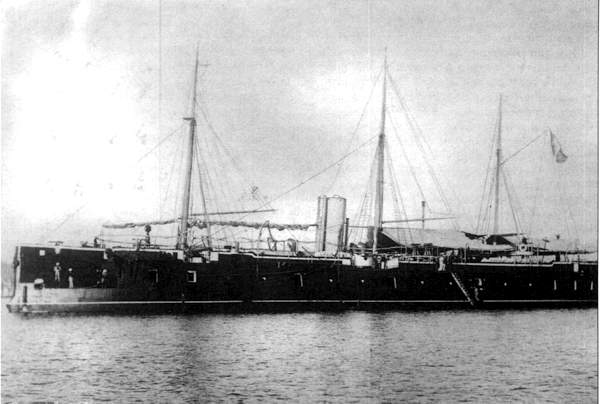
Both the Formidabile and Terribile were thus built in France, as lacking industrial facilities or experiences in the new type of ships, and not by “Italy” but by the Regia Marina Sarda (Royal Sardinian Navy), as variants of the Gloire design. They were indeed were ordered by Camillo Benso, Count of Cavour, then both the Prime Minister and Naval Minister of the Kingdom of Sardinia. They were even originally intended to be armored floating batteries, to deal with Austrian Fortifications along the Venetian coast, but they were redesigned as sea-going ironclads after construction started. They became, when Italy was unified, the frst step of major naval expansion program, for a fleet capable of defeating the Austrian Navy, still largely equipped with Venice-built Frigates and some ships of the line, including SMS Kaiser.
Laid down at FCM in June and December 1860, they were launched in 1861, paid for modifications, and completed in September 1861 and May 1862 for this time the brand new Regia Marina. Word of their construction immediately trigerred Austria to order the Drache class, built in Britain. And so started The Austro-Italian ironclad arms race:
⚙ The Austro-Italian naval Arms Race prior to Lissa (1864) | |
 Regia Marina Regia Marina |  KuK Kriegsmarine KuK Kriegsmarine |
|
Formidabile class 1860 Principe di Carignano class 1861 Re d'Italia class 1861 Regina Maria Pia class (1862) Roma class (1863) Affondatore (1863) Principe Amedeo class (ordered 1865) |
Drache class (1860) Kaiser Max class (1861) Erzherzog Ferdinand Max class (1863) |
Design of the class
 As the ship were completed, the Kingdom of Sardinia had unified with the rest of the Italian states and saw these vessels became the first ironclads built for the Italian fleet. These were essentially Wooden-hulled vessels plated with 4.3 inches (109 mm) of wrought iron and with a battery of twenty broadside, modern heavy guns.
As the ship were completed, the Kingdom of Sardinia had unified with the rest of the Italian states and saw these vessels became the first ironclads built for the Italian fleet. These were essentially Wooden-hulled vessels plated with 4.3 inches (109 mm) of wrought iron and with a battery of twenty broadside, modern heavy guns.
Hull and general design
As initial floating batteries, they had less refined lines, with a broad poop and stern, largely rectangular hull, but that early in construction it could be revised with a much taller freeboard, reworked stern and prow with more marine lines in general. Displacement as completed was 2,682 long tons (2,725 t) standard and 2,807 long tons (2,852 t) full load. They measured 63.05 meters (206 ft 10 in) long between perpendiculars and 65.8 m (215 ft 11 in) overall, for 14.44 m (47 ft 5 in) in beam and 5.45 m (17 ft 11 in) in draft. The stern was semi-clipper style, but the bow was triangular and straight, reinforced. There was no ram at first, it was added later. They carried a crew of 371 officers and enlisted men.
Armour protection layout
These ships were both entirely wooden-hulled vessels, but they received a belt of wrought iron armor plates starting a bit below the waterline, from prow to stern, all 109 mm (4.3 in) thick.
That was it. No Coning Tower (as on the Gloire) or armoured deck. ASW compartimentation existed only to carry coal and block its move when rolling, but in case of a perforation below the waterline, flooding was quick and total.
Powerplant
Their propulsion system comprised a single single-expansion marine steam engine driving a single four-bladed screw propeller. It was fed by steam from by six coal-fired rectangular boilers. These four boilers were trunked into a single funnel. Top speed was 10 knots (19 km/h; 12 mph), based on a total output of 1,080 indicated horsepower (810 kW). Terribile varied in output, reaching however 1,100 ihp (820 kW). Range was 1,300 nautical miles (2,400 km; 1,500 mi) at this speed however to spare the limited coal supply, as customary at the time, both ironclads had three masts in a classic schooner-rigged configuration: Bowsprit, fore, main and mizzen masts, then foresails and topsails, apart on the mizzen which had its main, larger mizzen sail. Top speed under full sail is unknown. Given the bulk, draft and weight of the hull, probaly below 8 knots in the most favourable winds.
Armament
As floating batteries, they were originally to be armed with thirty guns, 15 per side, and probably muzzle loading smoothbore models, but after conversion to broadside ironclads, it was reduced to twenty guns, ten per side, with a classic mix of four 203 mm (8 in) guns in the center of the battery, two per side, and and sixteen 164 mm (6.5 in), all modern rifled muzzle-loading guns. This was revised several times:
In 1878, the battery was reduced to eight 203 mm guns, four per side.
In 1885 Terribile was converted as training ship and received two 6 in (152 mm) guns, two 5.9 in (150 mm) guns and four 4.7 in (119 mm) guns all on deck.
In 1887 Formidabile underwent the same conversion but in her case, she only received six 4.7 in guns.
⚙ specifications as completed |
|
| Displacement | 2,682 long tons standard, 2,807 long tons FL |
| Dimensions | 65.8 x 14.44 x 5.45 (215 ft 11 in x 47 ft 5 in x 17 ft 11 in) |
| Propulsion | 1 shaft, marine steam engine, 6× Sq. fire-tube boilers 1,080 ihp (805 kW) |
| Speed | 10 knots (19 km/h; 12 mph) |
| Range | 1,300 nmi (2,400 km) at 10 kn |
| Armament | 4 × 203 mm (8 in) RML, 16 × 164 mm (6 in) RML |
| Protection | Belt armor: 109 mm (4.3 in) |
| Crew | 371 |
General assessment
The first ironclads of the the Regia Marina, quite a symbol for a newly-unified Kingdom. Bioth instantly became the core of the fleet, later to be augmented by the Principe di Carignano, Re d’Italia, and Regina Maria Pia classes. All would be centerpiece during the third Italian War of Independence against Austria, starting in June 1866. Italy allied with Prussia and indeed took advantage of the Austro-Prussian to seize Venice. The Italian fleet under Admiral Carlo Pellion di Persano was surprised while trying to seize the island of Lissa in mid-July, but on the 20th and Formidable, badly damaged against Austrian coastal fortifications was forced to retire before the battle. She hastily return, but too late as the two fleets had disengaged.
Her sister took part another unsuccesful bombardment and missed the battle. Quickly obsolescent, they were later modernized with new boilers and guns and turnedint training ships, missing the action on Civitavecchia in 1870 in the aftermath of Lissa, they survived into the early XXth century.
Read More/Src
Books
Fraccaroli, Aldo (1979). “Italy”. In Gardiner, Robert (ed.). Conway’s All the World’s Fighting Ships 1860–1905. London: Conway Maritime Press. pp. 334–359. ISBN 978-0-85177-133-5.
Greene, Jack; Massignani, Alessandro (1998). Ironclads at War: The Origin and Development of the Armored Warship, 1854–1891. Pennsylvania: Da Capo Press. ISBN 978-0-938289-58-6.
Ordovini, Aldo F.; Petronio, Fulvio & Sullivan, David M. (December 2014). “Capital Ships of the Royal Italian Navy, 1860–1918: Part I: The Formidabile, Principe di Carignano, Re d’Italia, Regina Maria Pia, Affondatore, Roma and Principe Amedeo Classes”. Warship International. Vol. 51, no. 4. pp. 323–360. ISSN 0043-0374.
Sondhaus, Lawrence (1989). The Habsburg Empire and the Sea: Austrian Naval Police, 1797–1866. West Lafayette: Purdue University Press. ISBN 978-0-911198-97-3.
Sondhaus, Lawrence (1994). The Naval Policy of Austria-Hungary, 1867–1918. West Lafayette: Purdue University Press. ISBN 978-1-55753-034-9.
Sondhaus, Lawrence (2001). Naval Warfare, 1815–1914. New York: Routledge. ISBN 978-0-415-21478-0.
Wilson, Herbert Wrigley (1896). Ironclads in Action: A Sketch of Naval Warfare from 1855 to 1895. London: S. Low, Marston and Company. OCLC 1111061.
Links
en.wikipedia.org Formidabile-class_ironclad
on marina.difesa.it/
Model Kits
None found so far, feel free to contribute here in comments !
Career of the Formidabile
 Formidabile (1861-1903)
Formidabile (1861-1903)

Formidabile in 1861 as completed
Formidabile was laid down by December 1860 at the “Société Nouvelle des Forges et Chantiers de la Méditerranée” shipyard in La Seyne, Toulon, Southern France (abbreviated as FCM) ordered by the Royal Sardinian Navy, launched on 1 October 1861 and was completed under orderes this time of the new Italian Kingdom, by May 1862. She hoisted the flag of the Regia Marina. After training in 1963-66, by June Italy declared war on Austria and she was placed under orders of Admiral di Persano, which had the time denied to enter any fight against the Austrian fleet, claiming he was waiting for the then completing ironclad ram Affondatore to be his flagship. The latter was a turret ironclad ordered in Britain. This inaction weakened morale and while Rear Admiral Wilhelm von Tegetthoff tried to lure them out of Ancona on 27 June, Persano aboard hs flagship Principe di Carignano was pressed to act by Minister Agostino Depretis, and after a sweep into the Adriatic by 16 July, he decided to attack Lissa, starting on the 18th.
The fleet escorted troop transports with 3,000 soldiers but he needed to silenced the Austrian batteries before landing and mobilized for this all his ironclads completed by frigates to soften the defences, split into three attack groups around the island. Formidabile was assigned to the 3rd Division with Terribile, Re di Portogallo and Regina Maria Pia as the coastal defense ship Varese. The 18th saw little results, and the Italians withdrew while Formidabile was ordered to enter the harbor at Vis the following day, and attacking the Madonna battery, supported by Castelfidardo, Ancona, and Principe di Carignano.
However the small harbor complicated manoeuvers, and Formidabile started to engage the Madonna battery alone as the other ships could not follow. The bombardment was unsuccessful and captain Simone Antonio Saint-Bon reported he suffered 50 casualties, taking much punishment without significant results. Hesailed out of Vis to the west if the Island, transferred his wounded men to a hospital ship and still was there when the following day the Austrian fleet attacked. She was ordered to return to the line but this was contested by Saint-Bon and instead he withdrew to Ancona…
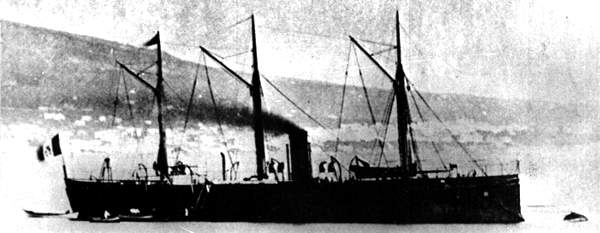
Formidabile in 1870
Persano was replaced by Admiral Giovanni Vacca for an attack on Pola, but Formidabile was still in repair. After the war, the naval budget was cut down, yet still the Italian ironclad squadron was srnt to attack Civitavecchia in September 1870, but ships were laid up, conscripted sailors sent home. Formidabile so did not took part in this action and was rapidly seen as obsolete. In 1872–1873 she received new boilers and was armed with just eight 8-inch guns. In 1887, she was discarded from the front line and anchored to serve as gunnery training ship for the remaining of her lifen, being rearmed a third time with samples of every gun used in the RN. Her late aspects was that she missed her bowsprit, her rig was discarded and only three simplified masts remained. In 1903 she was stricken and BU.
 Terribile (1861-1904)
Terribile (1861-1904)
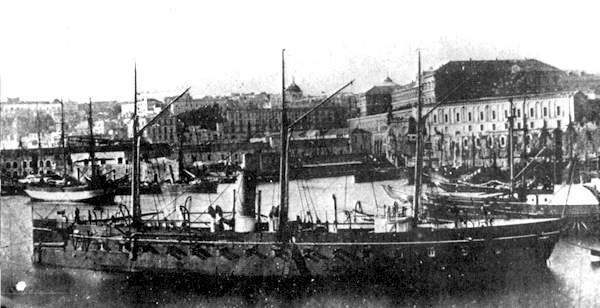
Terribile was built also at FCM, La Seyne on the French Riviera, laid down in June 1860 -earlier than her sister- launched on 16 February 1861, completed in September for the Regia Marina. After years of training, individual and in fleet exercizes, she was seen in action on June 27, when Terribile was carrying only half her guns at the time and after a sweep on 7 July, the attack on Lissa on 16 July, Terribile was assigned in the 3rd Division with her sister Formidabile (see above). She was withdrawn after an unsuccessful bombardment on the 18th. The following day she was ordered with Varese to attack the fortifications in the town of Comisa. But the batteries held firm and this was another failure, just as her sister in Vis harbour. The latter was badly damaged, but it was lighter for Terribile.
On the 20th, Terribile and Varese were at again on Comisa but jyst before they opened fire the dispatch boat Esploratore arrived to inform them to immediately leave and join the fleet as Tegettoff arived. Terribile and Varese were at that point nine miles to the west. They steamed up and retirned, then rushed to try to take their line abreast formation and line ahead formation. Terribile mostly saw little action, fired a few single long-range shots at Austrian flagship Kaiser. She only only arrived after Re d’Italia had been sunk, Palestro exploed. Her new order was withdraw as nigh fell fall, back to Ancona.
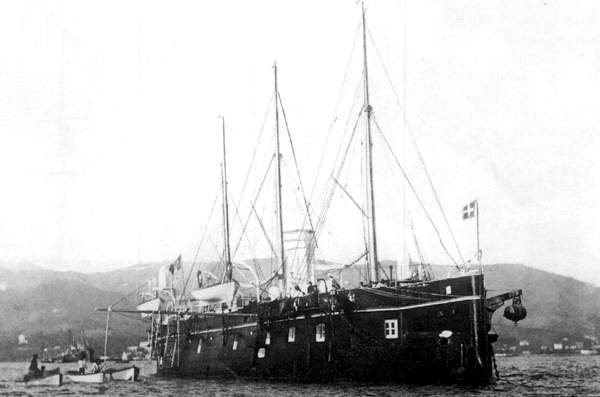
Terribile as TS in La Spezia, 1898
Under Admiral Giovanni Vacca she was mobilized to attacj Pola, but the war ended before. Postwar budget cuts left her unable to proceed for the attack on Civitavecchia in September 1870, laid up with her conscripted crew sent home. In addition she was growingly seen as obsolete. On 3 December 1872 she was driven ashore in a storm, i the bay of Naples, towed back and repaired. In 1872–1873, she was reboilered had only eight 8-inch guns. In 1885, she was modified as training ship with a few 6 in (152 mm) 5.9 in (150 mm) and two 4.7 in (119 mm) guns plus two torpedo tubes and served as such until 1904, until stricken and BU.

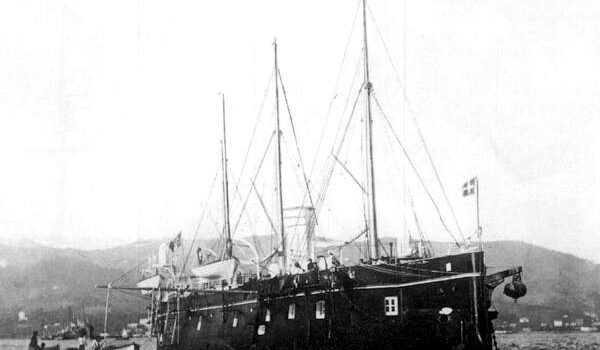
 Latest Facebook Entry -
Latest Facebook Entry -  X(Tweeter) Naval Encyclopedia's deck archive
X(Tweeter) Naval Encyclopedia's deck archive Instagram (@navalencyc)
Instagram (@navalencyc)





 French Navy
French Navy Royal Navy
Royal Navy Russian Navy
Russian Navy Armada Espanola
Armada Espanola Austrian Navy
Austrian Navy K.u.K. Kriegsmarine
K.u.K. Kriegsmarine Dansk Marine
Dansk Marine Nautiko Hellenon
Nautiko Hellenon Koninklije Marine 1870
Koninklije Marine 1870 Marinha do Brasil
Marinha do Brasil Osmanlı Donanması
Osmanlı Donanması Marina Do Peru
Marina Do Peru Marinha do Portugal
Marinha do Portugal Regia Marina 1870
Regia Marina 1870 Nihhon Kaigun 1870
Nihhon Kaigun 1870 Preußische Marine 1870
Preußische Marine 1870 Russkiy Flot 1870
Russkiy Flot 1870 Svenska marinen
Svenska marinen Søværnet
Søværnet Union Navy
Union Navy Confederate Navy
Confederate Navy Armada de Argentina
Armada de Argentina Imperial Chinese Navy
Imperial Chinese Navy Marinha do Portugal
Marinha do Portugal Mexico
Mexico Kaiserliche Marine
Kaiserliche Marine 1898 US Navy
1898 US Navy Sovietskiy Flot
Sovietskiy Flot Royal Canadian Navy
Royal Canadian Navy Royal Australian Navy
Royal Australian Navy RNZN Fleet
RNZN Fleet Chinese Navy 1937
Chinese Navy 1937 Kriegsmarine
Kriegsmarine Chilean Navy
Chilean Navy Danish Navy
Danish Navy Finnish Navy
Finnish Navy Hellenic Navy
Hellenic Navy Polish Navy
Polish Navy Romanian Navy
Romanian Navy Turkish Navy
Turkish Navy Royal Yugoslav Navy
Royal Yugoslav Navy Royal Thai Navy
Royal Thai Navy Minor Navies
Minor Navies Albania
Albania Austria
Austria Belgium
Belgium Columbia
Columbia Costa Rica
Costa Rica Cuba
Cuba Czechoslovakia
Czechoslovakia Dominican Republic
Dominican Republic Haiti
Haiti Hungary
Hungary Honduras
Honduras Estonia
Estonia Iceland
Iceland Eire
Eire Equador
Equador Iran
Iran Iraq
Iraq Latvia
Latvia Liberia
Liberia Lithuania
Lithuania Mandchukuo
Mandchukuo Morocco
Morocco Nicaragua
Nicaragua Persia
Persia San Salvador
San Salvador Sarawak
Sarawak Uruguay
Uruguay Venezuela
Venezuela Zanzibar
Zanzibar Warsaw Pact Navies
Warsaw Pact Navies Bulgaria
Bulgaria Hungary
Hungary

 Bundesmarine
Bundesmarine Dutch Navy
Dutch Navy Hellenic Navy
Hellenic Navy Marina Militare
Marina Militare Yugoslav Navy
Yugoslav Navy Chinese Navy
Chinese Navy Indian Navy
Indian Navy Indonesian Navy
Indonesian Navy JMSDF
JMSDF North Korean Navy
North Korean Navy Pakistani Navy
Pakistani Navy Philippines Navy
Philippines Navy ROKN
ROKN Rep. of Singapore Navy
Rep. of Singapore Navy Taiwanese Navy
Taiwanese Navy IDF Navy
IDF Navy Saudi Navy
Saudi Navy Royal New Zealand Navy
Royal New Zealand Navy Egyptian Navy
Egyptian Navy South African Navy
South African Navy






























 Ukrainian Navy
Ukrainian Navy dbodesign
dbodesign